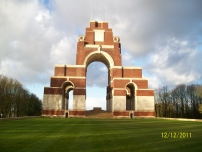| First Name: | Horace Bright | Last Name: | HULL | |
|---|---|---|---|---|
| Date of Death: | 01/07/1916 | Lived/Born In: | East Sheen | |
| Rank: | Corporal | Unit: | London2 | |
| Memorial Site: | Thiepval Memorial | |||
Current Information:Enlisted-London
The opening day of the Battle of the Somme 1st July 1916 This was a disastrous day for the British Army in France. Eleven divisions of Fourth Army attacked along a 15 mile front from Maricourt to Serre. Two further divisions of Third Army launched a diversionary attack just to the north of Serre at Gommecourt. For a week beforehand the British artillery pounded the enemy trenches but the Germans had been there for a long time and they had constructed deep, concrete reinforced shelters beneath their trenches and many survived the bombardment. The troops went over the top at 7.30 am but even before they had left their overcrowded trenches, many had been killed or maimed by German artillery. The Germans knew that they were coming. Once in No-Man’s-Land the artillery continued to take its toll and then the machine guns opened up on the advancing British infantry. They fell in their thousands and the attack came to a standstill almost everywhere. Survivors sought cover wherever they could find it and at night they crawled back to their own lines, often dragging a wounded soldier with them. Only in the south were any advances made with the attack on Fricourt and Mametz. Over 19,000 British soldiers were killed on this day, including 2,500 from London. The attack on Gommecourt The 56th (London) Division and the 46th (North Midland) Division carried out the diversionary attack on Gommecourt. It was intended to draw German reserves away from the main battle further south and to pinch out the Gommecourt salient but It failed on both counts. The German defences at Gommecourt were among the strongest any British attack faced on 1st July. Nevertheless 56th Division’s attack on the southern edge of the salient began promisingly. The first two German lines were taken but they could get no further. 46th Division’s attack came to grief on the uncut wire and by the end of a very bloody day all but the dead and injured were back in their own trenches. The 2nd London battalion were the reserve battalion of 169 Brigade, 56th Division on 1st July. As the attack began a party of 20 men from the battalion were detailed to follow in the wake of 5th London carrying trench mortar ammunition which they did successfully but not without losing over half of their number, mostly when still in their own trenches. The attacks by 5th, 9th and 16th London, the other battalions of 169 Brigade, although initially successful, soon ran into trouble. The Germans recovered from the initial assault and began to man their reserve trenches and sent strong bombing parties from Gommecourt Park against the British lodgement. At the same time their artillery, which had been targeting the British front line, now began plastering no man’s land. In the early afternoon, with things looking desperate, Brigade HQ ordered 2nd London into the fight. “C” Company advanced across no-mans land at a time when the German barrage was at its heaviest and with machine guns firing from Gommecourt Park, they never stood a chance. Very few reached the German trenches and none were able to get any further. The same fate befell “A” Company at which stage any further attempts were called off. That evening the last survivors of 56th Division were back in their own lines. Horace Hull was one of the many men from 2nd London who did not survive the day. |
||||
| « Back to Search Results | ||||
| If you think any of the information shown here is incorrect, Click Here to submit your amends and comments | ||||




